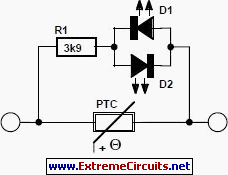FREE
circuits!
How to build Simple Short-Circuit Detection
September 27, 2010 - category: Conductivity testerDescription
This circuit is suitable in every situation where over-current protection is required. Here we give an example from the model train world. Every seasoned model train enthusiast knows that there is nothing worse than having to find the cause of a short-circuit. On a small model railway with one locomotive it is obviously fairly easy, but on large layouts all locomotives stand still when there is a short and then you have to check each one in turn to find the culprit.
If the track is divided into sections then we can use this super simple circuit to make our lives a lot easier. A multifuse is inserted into one of the supply lines for each of the sections. (A multifuse is also called a multiswitch, polyfuse or polyswitch, depending on the manufacturer). This is a type of fuse that cools down and conducts normally again once the short has been removed. The advantage is that only the section with the short becomes isolated.
All the other locomotives in the other sections continue to move. The stationary locomotive is in principle the culprit, but it’s quite likely that several locomotives aren’t moving since not all of them would be travelling in the first place. For this reason we connect an LED indicator across each multifuse, making it clear which section caused the problem. You can choose any color LED, but we recommend that you use low-current types that emit a lot of light at only a few mA.
Circuit diagram:
The value of the current limiting resistor may be changed to give an acceptable LED brightness. As long as the current is small, the resistance of the multifuse is also low and there will barely be a voltage drop. At high currents the resistance increases, which causes a voltage drop across the multi-fuse that is large enough to light up the LED. As we don’t know the direction of the current flow (the train could be moving either forwards or backwards and digital controls use an alternating current) we connected two LEDs in parallel with opposite polarities.
Multi-fuses are available for many different trip currents. Choose a value that is slightly higher than the maximum current consumption of a locomotive in a section. The table below shows the characteristics of several types from the MF-R series made by Bourns. (Raychem is another well-known manufacturer of poly-switches.) Ihold is the current at which the multifuse still conducts normally, Itrip is the short-circuit current.
author: Karel Walraven, Elektor Electronics Magazine – 07/2005
circuit from http://www.extremecircuits.net/2010/05/simple-short-circuit-detection.html


 This category
This category